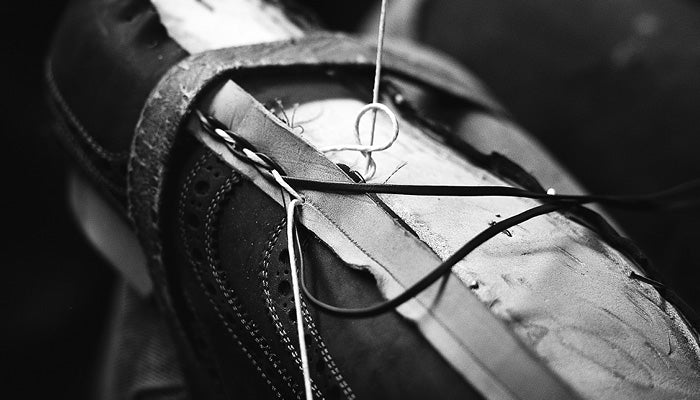Shoe lasts
The finished shoe is only as good as the last on which it is built. During production, this simulates the human foot, including its characteristics.
Step embroidery
In the stitching workshop, the cut leather pieces are sewn together. After the upper leather, the lining follows. The shaft is reinforced with a front and back cap. The bugging process also takes place in the stitching workshop. This involves gluing the visible edges of the shaft inward and providing the holes in the leather pieces with reinforcements.
Assembly department
The assembly department is the heart of shoe production, where most of the work steps are carried out:
- The insole is cut from approximately 4 millimeter thick, pit-tanned leather according to the shape of the last. It is the base of the shoe, to which the frame and shaft are sewn. A welt-groove is worked into the insole using a welt-groove plane. The welt seam will run along this groove.
- The upper is now pulled over the last by hand and nailed piece by piece. It rests on the last for about a day before a final tightening takes place. This elaborate process guarantees the long-lasting shape retention of Dinkelacker shoes.
- The insole, upper and frame are connected with the insole stitch. Shoemakers use a thick twine for this, which is previously coated with pitch for better durability.
- The heel counter, a frame made of firm leather, is attached with special nails, the so-called tacks. These are riveted on the inside of the insole. Next, the heel piece is installed, a component made of a composite material and a steel joint. This gives the rear part of the shoe stability and prevents the joint from breaking through.
- Stitch by stitch, leather straps are interwoven into the welt and double seam. This creates the characteristic braided seam that is typical of Dinkelacker. The outsole is then placed on the doubled midsole. Its edges are smoothly milled by steady hands before being reinforced by up to 168 brass nails. These are also found in the heel - they reduce wear and tear. Nail by nail is hammered in by hand.
- Next, the brass tip is marked on the tip of the outsole before this area is cut out and screwed on with the visually impressive tip. It is especially recommended for men who run heavily on the balls of their feet.
- The heel front is smoothed with a shard of glass and any remaining unevenness is removed. The doubled frame is then tapped, notch by notch, and the soles are sanded. In the process called "letting down," the sole edge is flattened with a special knife before being dyed.
Finishing and quality control
Before the shoes are subjected to a final inspection and put up for sale, they receive their finishing touches: shoe cream is applied, laces are inserted, and the shoe is polished to a high shine. The shoe is now ready!














